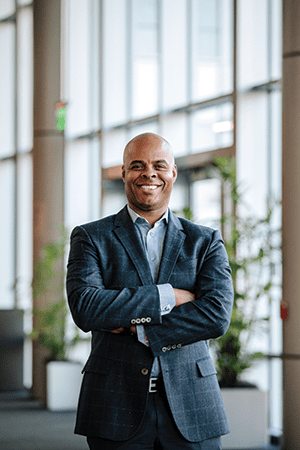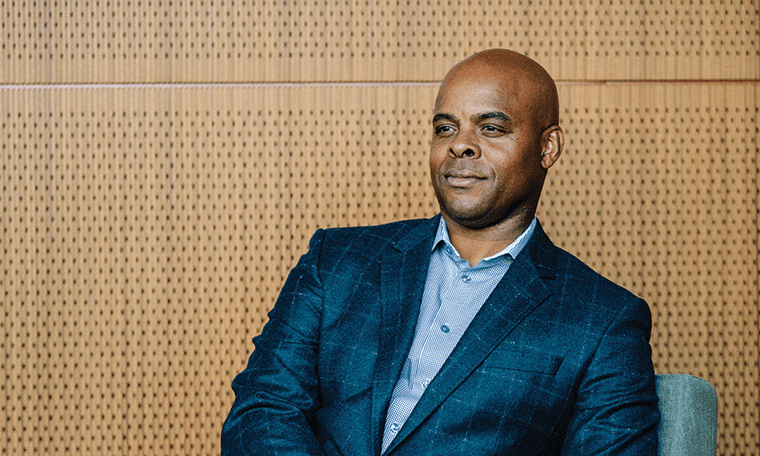When Brian Miller was just 6, his mother, an accountant by training, would take out her ledgers and spreadsheets, lay them on the floor and invite her young son to play a game.
“Literally she would spread them on the floor and say, ‘I’m off by two cents. Help me find it,’ ” Miller said.
The hunt for the missing money was one of the ways Miller’s mother, who earned a master’s degree, became a CPA and eventually a chief financial officer while raising her two sons alone, taught him to develop perseverance and stamina.
“Mom is an amazing woman. She taught me I need to get better every day and be the best at your craft,” he said.
It’s a lesson Miller has carried with him throughout his career, whether as a middle school teacher or now as vice president of talent, development and inclusion at Gilead Sciences, one of the world’s leading biopharmaceutical companies.
Early Career
Born in St. Louis, Miller grew up in Pasadena, California. After graduating with an economics degree from the University of the Pacific, he was teaching math to middle school students when on a dare, he applied to the master’s program in education at Harvard University.
“The acceptance came in on April 1 and I thought it was a joke,” he said.
At Harvard, Miller also took courses through Harvard Business School and the Kennedy School for Government, sparking an interest that led him to create his own consulting company after graduation. He later went on to work for Ninth House, one of the first companies to create high-quality learning simulations, and the Forum Corp., a pioneer of “insourced” training.
“The things I gravitate toward are things that are just on the edge of something different,” Miller said.
Looking to move into an inside role at a company, Miller joined Amgen, a biopharmaceutical company in Southern California, as a manager of learning operations in 2005.
That transition to corporate education came with a few realizations. Unlike in consulting, there’s no walking away from organizational challenges. “A consultant can say here’s what you should do, here’s what it looks like … and then move on,” he said. “When you’re internal, there’s no moving on. You live with that solution year over year over year.”
That helped Miller realize the importance of character and competence. “Your words really land and stay,” he said. “You really have to be thoughtful about what you put into an organization because it has ripple effects and it typically will stay around.”
As Miller moved his way up the organization and was promoted to director of learning and development, he learned the importance of communication and clear direction. “We don’t give enough time to the why,” Miller said. “We give a lot of time to the what we’re doing and how we’re going to get it done.”
It was that thoughtful, deliberate mindset that would play a direct role in the next step of Miller’s career.
The Need to Lead
When Katie Watson went looking for a leader to build a new corporate learning function at Gilead Sciences, a biopharmaceutical company, she had a clear idea about the why.
The biopharmaceutical company, founded in 1987 in Foster City, California, outside of San Francisco, was on an extended run of success because of its pioneering antiviral drugs but many senior leaders had been there a long time, a source of tremendous value but also potential risk.
“From a strategy standpoint, it was key for us to make sure we were getting that next level of leaders ready to take on those important next roles,” said Watson, executive vice president of human resources and herself a 15-year veteran.
At that point, the L&D team consisted of one person mostly working on strategy. Miller, who had flown up for the day from Southern California to interview, presented his strategy to build a department.
“I was willing to declare my point of view — right, wrong or in between,” Miller said. “I think they saw me as a guy who is … going to put it out there to be debated and then he’s going to work his tail off to execute.”
Watson, who had been interviewing for months, saw in Miller something that pushed her to act faster than Gilead normally likes to move. “Before he even flew back down to Southern California we had made him an offer,” she said.
Miller’s experience at a peer company along with his consulting expertise were strong selling points but it was his preparation and approach that sold Watson. “He had the vision for where we wanted to go but also the patience to say we don’t need to throw everything at it in Year One,” she said.
Miller, offer now in hand for the short flight back home, knew he was at a potential turning point. “It’s one of those change-your-life moments,” he said. “There are moments in your life that will change the trajectory of your career as well as your life and your family.”
At the time, Gilead employed about 4,200 people and was on the cusp of rapid growth. But it was the opportunity to build a learning and development function from the ground up that pushed Miller to join the company in April 2010 as director of learning and development.
‘Swiss Army Knife-Type Talents’
As he settled in to his new role, Miller asked for time to observe for a while before hiring a staff. “That gave me the opportunity to go in a totally different direction,” he said. “Year One the direction was to build the department closer to a consulting company.”
Miller eschewed traditional L&D job roles like instructional design and classroom trainer and opted instead to focus on building analytics and project management capability.
He went looking for what he called “Swiss army-knife type talents,” experienced learning professionals who had the ability to consult and analyze business problems. “Getting that sort of talent to come, I knew we’d have the opportunity to play very broad across the organization,” he said.
That measured, methodical approach matched Gilead’s science-based culture. “One of Gilead’s key strengths historically has been its ability to focus on one thing at a time — first HIV then hepatitis C — and just completely dominate the market,” said Michael Douglass, health care industry analyst and deputy managing editor at The Motley Fool, a multimedia company that provides investment advice.
As those treatments have matured, Gilead has diversified outside of its core areas of expertise into new areas such as autoimmune disease and cancer. “I’d be more concerned about the risk of trying to do too many things at once but Gilead has been thoughtful and careful in its approach,” Douglass said.
That culture of deliberation has worked in Miller’s favor. “That first year was a lot of hard work on my end but it set the right trajectory for the function,” he said. “We are not a big team. We have to embrace the scramble … but we enjoy that.”
From Watson’s perspective, the time Miller and his team spent to get to know the business and meet with leaders was well spent. “If you were to go out and ask people at Gilead, he and his function have so much credibility and are so well regarded,” she said. “And it is because not only are the programs they create well done and well aligned with what the business needs but they took the time to engage the business.”

Learning Looks Like Gilead
While Miller took a measured approach to get to know Gilead’s business and put the right team in place, that didn’t mean he wasn’t looking for quick wins. Senior leader development, the issue that concerned Watson when hiring an L&D leader, was first.
Despite having just a small team in place, Miller decided to develop a custom three-day program that would match Gilead’s culture and leadership values. The business simulation and case study at the heart of the program came directly out of multiple meetings with the CEO and divisional presidents. “Every bit of that looks like Gilead,” Watson said.
The process Miller went through to create the program was as important as the program itself because it underlined for senior leaders the importance of developing the next generation of Gilead leaders.
“They committed that not only would their people be going to these programs but they would be there,” Watson said. “They would attend part of it and talk to that next stage of leader.”
That ongoing engagement with the program, even several years later, is how Miller and Watson recognize they’re achieving results from their development efforts. While Gilead tracks formal measures for programs, it’s the ongoing commitment from veteran leaders, some of whom had not engaged in leadership development in the past, that stands out.
“We are such a data-driven company … yet something in the experience made them pause and think about the type of leader they want to be or something in the business simulation made them pause and think about how they interact with their peers,” said Watson. “That’s compelling to me.”
Miller and his 13-member team have jumped at other opportunities to contribute to Gilead’s business. During a time when the company was growing rapidly through acquisition, they partnered with a longtime executive in Gilead’s research and development group to build a half-day culture training session to help new hires understand how Gilead works and why it works that way.
Watson said half of the company has made that training mandatory, an unusual step for Gilead.
When Gilead considered adding a new core value — inclusion — for the first time in 12 years, Miller and his colleagues put together a 90-day sprint team to dive into the data and present the business case. Then they made the case for why L&D should lead the charge. “It’s a behavior change issue, a culture change issue,” Miller said.
Miller credits his team’s ability to methodically approach business challenges and uncover business value as key to their success. “The things that are core — there’s where you really want to stare into that one, we want to wallow around in things that we know that the business really values,” he said.
It’s an approach that has also advanced Miller’s own career. He recently took over all of Gilead’s talent management and succession planning in addition to learning.
Succession is on the minds of investors. When Gilead veteran John Milligan took over as CEO from longtime leader John Martin in 2016, it was a signal that the company would approach growth much as it has in the past, Douglass said, but the recent retirement of COO Kevin Young has analysts watching carefully.
“One of the things I most respect about Gilead is that its management team is deliberate in its growth plans,” Douglass said. “This isn’t a company that wastes a lot of money each quarter trying to make Wall Street and short-term shareholders happy. That care — some would call it slowness — has almost certainly depressed the stock price in the last couple of years … but it’s the right answer for long-term, sustainable growth.”
Kind of like how finding the missing two cents in the ledger is the right way to teach a 6-year-old the value of perseverance and dedication to your craft.
Mike Prokopeak is vice president and editor in chief of Chief Learning Officer magazine. Comment below or email editor@CLOmedia.com.















